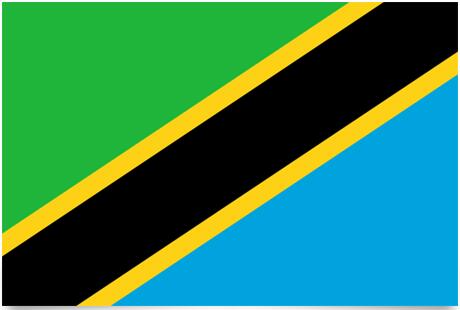Tanzania Flag and Meaning
Flag of Tanzania

Tanzania Flag Meaning
The flag of Tanzania was adopted on June 30, 1964 with the proportions 2: 3. The flag is blue and green with a delimiting black field that runs diagonally from the lower left corner to the upper right corner. The black field is also separated from the other fields by a yellow stripe on each side. The creation of the flag was when Tanganyika and Zanzibar were united and part of a union.
The flag is based on the flags of the two countries, Tanganyika which has two green horizontal fields with a black field with yellow stripes around it in the same direction and from the Zanzibar flag they took the blue color. The black stands for the country’s population, the green color symbolizes the country, blue stands for the sea and yellow symbolizes the country’s mineral finds.
Tanzania Overview
| Population | 35.1 million |
| Currency | Tanzania shilling |
| Area | 883.749 km² |
| Capital city | Dodoma |
| Population density | 39.7 residents/km² |
| HDI location | 148 |
The country consists of the ancient land of Tanganyika as well as the islands of Zanzibar, Pemba and Mafia. The islands are of coral origin. On the mainland, the landscape and climate are varied. The coastal area facing the Indian Ocean is flat and its climate is tropical and rainy. The majority of the population is concentrated at the same time. Further to the west lies the central plateau where the climate is dry and plagued by tsetse fly. The northern part of the country is mountainous, but the slopes are suitable for farming. It is also in this area that Africa’s largest mountain, Kilimanjaro (6,000 m) is found. The area around Lake Victoria is densely populated and irrigation is used in agriculture. Along the coast there are large sisal and sugar cane plantations. The need to increase exports leads to an increase in agricultural production, even in semi-arid areas. This has led to increasing soil erosion. At the same time, the untamed deforestation continues.
The people: The Tanzanians have predominantly Bantu background, and are divided into 120 ethnic subgroups. In the western part of mainland Tanzania there are also nilocamitic groups. In Zanzibar, there is the minority Shivazi, of Persian origin. In both places there are groups of Arabs, Indians, Pakistanis and Europeans.
Religion: Islam (35%), traditional cults (35%) and Christianity. In Zanzibar, 99% of the population is Muslim.
Languages: Swahili and English (official) as well as about 100 local languages
Political parties: Tanzania Revolutionary Party (CCM, Chama Cha Mapinduzi), socialist, formed February 5, 1977 by the merger of the Tanganyika African National Union (TANU) founded by Julius K. Nyerere in 1954 and the Afro-Shirazi Party of Zanzibar. In 1992, multi-party rule was allowed. Today, there exist, among other things. the following parties: the Democracy and Progress Party (CHADEMA); The Civil United Front (CUF); National Convention for Building and Reform (NCCR-Mageuzi); The Movement for Democratic Alternative (MDA) on Zanzibar.
Social organizations: Organization of Tanzania Trade Unions (OTTU); Union of Tanzanian Women (UWT); Union of Tanzanian Cooperatives (WASHIRICA); The Association of NGOs in Tanzania (TANGO) has about 500 members; The National Union of Students in Tanzania (MUWATA).
Official Name: Jamhuri ya Muungano wa Tanzania.
Administrative division: 25 regions
Capital: Dodoma, official capital, 324,347 residents (2002).
Other important cities: Dar-Es-Salaam, 2,372,200 residents; Mwanza, 291,900 residents; Tang, 202,900 residents; Zanzibar, 247,500 residents (2000).
Government: John Pombe Magufuli has been President since November 2015. In addition, Vice President (Samia Suluhu) also serves as President of Zanzibar and Pemba. Kassim Majaliwa has been prime minister since November 2015. Parliament has one chamber with 343 members.
National Day: April 26 (Day of the Association, 1964)
Armed Forces: 27,000 (2003).
Paramilitary forces: 1,400 (Land Police), 85,000 (militia).













































